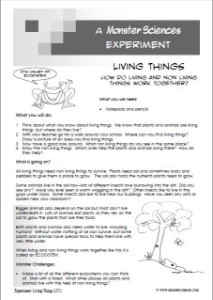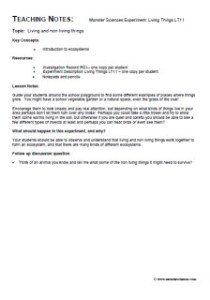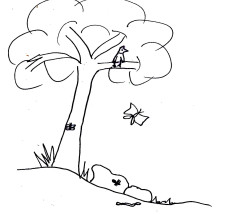Living and non-living things work together in nature to form an ecosystem – in this experiment your students will explore mini ecosystems in their own school and investigate how the living and non-living things interact.
 |
 |
What you will need:
- Notepads and pencils
What you will do:
1 Think about what you know about living things. We know that plants and animals are living things, but where do they live?
2 With your teacher go for a walk around your school. Where can you find living things? Draw a picture of an area you find living things.
3 Now have a good look around. What non living things do you see in the same place?
4 Draw the non living things. Which ones help the plants and animals living there? How do they help?
What is going on?
All living things need non living things to survive. Plants need soil and sometimes rocks and pebbles to give them a place to grow. The soil also holds the nutrients plants need to grow.
Some animals live in the soil too—lots of different insects love burrowing into the dirt. Did you see any? Have you ever seen a worm wriggling in the dirt? Other insects like to live in the gaps under rocks. Some insects also like to live near our buildings. Have you seen any ants or spiders near your classroom?
Bigger animals also depend on the soil but most don’t live underneath it. Lots of animals eat plants, so they rely on the soil to grow the plants that are their food.
Both plants and animals also need water to live, including humans! Without water nothing at all can survive, but some plants and animals have special tricks to help them live with very little water.
When living and non living things work together like this it is called an ECOSYSTEM.
Monster Challenges:
- Make a list of all the different ecosystems you can think of. Start with a forest. What other places do plants and animals live with the help of non living things?
Teaching Notes:
Topic: Living and non living things
Key Concepts:
¨ Introduction to ecosystems
Resources:
- Investigation Record IR01– one copy per student
- Experiment Description Living Things LT11 – one copy per student
- Notepads and pencils
Lesson Notes:
Guide your students around the school playground to find some different examples of places where things grow. You might have a school vegetable garden or a natural space, even the grass of the oval!
Encourage them to look closely and pay real attention, but depending on what kinds of things live in your area perhaps don’t let them turn over any rocks! Perhaps you could take a little trowel and try to show them some worms living in the soil, but otherwise if you are quiet and careful you should be able to see a few different types of insects at least and perhaps you can hear birds or even see them?
What should happen in this experiment, and why?
Your students should be able to observe and understand that living and non living things work together to form an ecosystem, and that there are many kinds of different ecosystems.
Follow up discussion question:
- Think of an animal you know and tell me what some of the non living things it might need to survive?
Get this experiment here or as part of a bundle of Living Things Experiments here.



